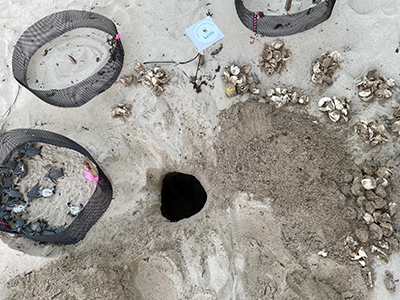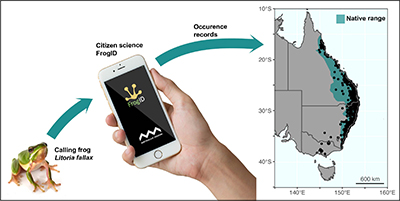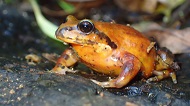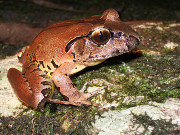Transitions: between water and land
Undisturbed, ‘dry’ green turtle nests on Raine Island and Heron Island have similar hatching success ~70%; however, most embryo mortality occurs early during incubation at Raine Island but late during incubation at Heron Island. A nest on Heron Island has been excavated to assess hatching success. Photograph by David Booth.
Up to date information on the distribution of invasive species is vital to biodiversity conservation but difficult to obtain. We use data from a national citizen science project, FrogID, to examine the distribution of the eastern dwarf tree frog (Litoria fallax) in Australia. These data reveal that the species has established populations far outside its native range and that these populations are spreading, highlighting the value of citizen science in detection and monitoring of invasive species. Photograph by Jodi Rowley.
Populations of the endangered western saw-shelled turtle lack juvenile recruitment, most likely due to nest depredation by foxes. We optimised egg incubation techniques to achieve a 97% hatching success rate. The artificial incubation of western saw-shelled turtle eggs bypasses fox predation and provides an effective way to produce hatchling turtles for augmenting wild populations. Photograph by David Waugh.
Population monitoring is required to guide conservation programs. We conducted a mark–recapture study of a population of the vulnerable green and golden bell frog in a large coastal lagoon in north-east New South Wales. We estimate that this population contains 350–850 adult frogs.
Photo by D. Newell.
An assessment of mitochondrial and morphological diversity in frogs previously assigned to Litoria caerulea from New Guinea reveals two taxa. Shallow genetic divergence in true L. caerulea from across southern New Guinea and Australia implies recent Pleistocene connectivity across now isolated savannahs, while the more deeply divergent new species suggests earlier Pliocene divergence across lowland tropical habitats of Sahul.
Photo by S. J. Richards.
Globally, montane amphibian species are under severe pressure from climate change. Despite this, basic monitoring is lacking for many of these species. In this study, we found that the mountain frog (Philoria kundagungan) has a highly restricted and fragmented distribution, being limited to ~11 km2 of potentially suitable habitat. In light of the continued pressures of climate change, the results of our surveys and the approach used will be vital for assessing the impacts and formulating management actions.
Photo by Liam Bolitho.
Construction of Wyaralong Dam in South East Queensland was predicted to impact resident freshwater turtle species and their habitat. The relative abundance of the Macquarie River turtle (Emydura macquarii macquarii) and the common sawshell turtle (Myuchelys latisternum) was monitored during the dam’s first five years of operation. Results indicate that spatial and temporal variability in the relative abundance of the two turtle species occurred during the study but not all expected impacts were realised.
Photo by Seqwater.
Chelodina expansa is an endangered turtle threatened by invasive red fox depredation on nests. Our study identified environmental variables associated with nest site preferences in C. expansa, including elevation above water, ground cover and vegetation. It allows the identification of nesting habitat that can be targeted for conservation management.
Photo by Jeremy Pike.
The Mary River turtle has endured long-term recruitment failure due to multiple impacts across its life-history and is protected under various legislation. This study investigated the nesting behaviour of Elusor macrurus, including the environmental drivers that affect nest inundation. Results will inform the development and assessment of e-flow strategies for nesting of E. macrurus in terms of current, and future water resource development.
Photo by Marilyn Connell.
Describing the population trends of threatened species is central to conservation. We conducted mark–recapture modelling for a population of green and golden bell frogs in two periods, 17 years apart. There was no evidence this unmanaged population was in decline. We highlight factors that may cause bias in population modelling.
Photo by Sergio Jacomy.
Marine turtle nesting activity in the Pilbara region of Western Australia is not well defined. Between 1992 and 2012, using the track census approach, surveys identified reproductive habitat and described species-specific abundance of adult flatback (Natator depressus), green (Chelonia mydas) and hawksbill (Eretmochelys imbricata) turtles at 154 locations in the Pilbara region of Western Australia.
Photo by Catherine Bell.
The mitochondrial genome of the Mary River turtle exhibits the standard vertebrate arrangement of 37 genes. Assessment of genetic variation among 22 individuals sampled across the natural distribution revealed only two control region haplotypes. This limited variation probably reflects a narrow distribution and recent history of exploitation.
Photo by Marilyn Connell.
Litoria nannotis is an endangered frog from the wet tropics region in north Queensland that has suffered significant population declines. We used 454-shotgun sequencing to develop microsatellite loci. These will be useful in understanding the genetic variation and connectivity amongst populations of this species recovering from mass population declines.
Photo by Robert Puschendorf.
The western saw-shelled turtle, Myuchelys bellii, is more widely distributed and abundant in New South Wales than previously recognised, comprising four disjunct populations in larger, cooler rivers upstream of barriers to turtle dispersal. It is threatened by competition with an invasive native turtle, Emydura macquarii, and possibly by predation, disease and drought.
Photo by Bruce Chessman.
Fleay’s barred frog (Mixophyes fleayi) is an endangered species in need of periodic monitoring to determine population trends. We conducted capture–mark–recapture at Brindle Creek in Border Ranges National Park, New South Wales. Population modelling suggests the local population has remained relatively stable for up to 10 years.
Photo by Ross Goldingay.

















